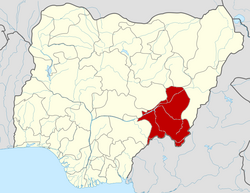This article needs additional citations for verification .(February 2020) |
Gashaka Serti | |
|---|---|
| Nickname: Baruwa | |
 Interactive map of Gashaka | |
| Country | |
| State | Taraba State |
| Local Government Headquarters | Serti |
| Government | |
| • Lamido | Dr Zubairu Hammangabdo |
| • Local Government Chairman and the Head of the Local Government Council | Hon. Umar Yusuf (Aluran Gari) |
| Time zone | UTC+1 (WAT) |
Gashaka is a Local Government Area in Taraba State, Nigeria. Its headquarters are in the town of Serti.
It has an area of 8,393 km2 and a population of 87,781 at the 2006 census.
The postal code of the area is 672. [1] The Lamdo (Emir) of Gashaka is Alhaji Zubairu Hammangabdo Muhammadu Sambo. He was installed on 28 January 2017 after the demise of his father Alhaji Hammangabdo Muhammadu Sambo who had ruled the Gashaka kingdom for 51 years and died on 23 October 2016 at the age of 81. Fulani is the major spoken language in Gashaka and Serti town.
There 10 Wards in GASHAKA local government area namely :GALUMJINA, GANGUMI, GARBABI, GASHAKA, GAYAM, JAMTARI, MAI‐IDANU, MAYO SELBE, SERTI ‘A’, SERTI ‘B’
